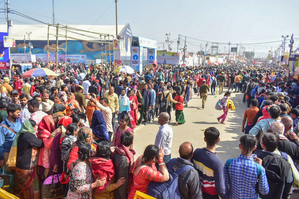The current state of fashion is comfort, which means comfortable, casual-aesthetic clothing is becoming the consumers lifestyle now. Moreover, the modern consumer has also become more health conscious, and wants to look after their wellness, and athleisure is making it easier for them, notes a major global lifestyle brand.
Guess, which relaunched its retail presence at the DLF Mall of India in Delhi-NCR, says the store is inspired by the rapidly evolving style preferences and buying habits of the new-age consumer, which has led to launch the ‘Athleisure’ collection “which had zero penetration in the pre-covid era, but now this category represents 7 per cent of our apparel sales. These figures are significant as quarantine consumers are clearly choosing comfort-driven apparels with a considerable shift towards fitness.”
Speaking to IANSlife, Manoj Kumar Nair, CEO of Gaurik Lifestyle which has brought Guess to India, says the athleisure collection addresses the same shift in trend. “For far too long, there have been a restricted few options for activewear in our country. What the consumers need is a more fashion-centric, trendy approach to activewear which this collection will be introducing. Guess’ Athleisure Collection will be the bridge between comfort and style and sits right at the junction of exclusivity.”
Another key category to look out for is a wide range of handbags – from satchels to totes and backpacks to luggage, there is something for everyone at the store.
Speaking about the upcoming fashion trends in terms of accessories, that will be big in 2021, he says:
“As per a Unicommerce Report, the online fashion industry has grown 51 per cent in this financial year. Accessories are coming in as the favourites of the new age consumer. We should be looking at bold, statement pieces to accentuate the more casual athleisure apparel. Chunky, gold-tune jewellery paired with pastel coloured, over the top sunglasses is something that balances the casual aesthetic. We’re again going extreme with the bags- from mini, shoulder bags to large totes, everything makes sense to Gen Z and Millennials.”
Nair also says that: “We need to note that even though digitalization of shopping has gone up during the pandemic, brick and mortar is here to stay. It enables a brand to create an experiential environment for the consumer. So, one has to complement the other for the brand to survive.”
“Another key element to observe in the following years is the incoming sustainable revolution. Millennials and Gen Z, who account for more than half of the sales in the industry, are the flag bearers of this revolution and they wish to associate themselves with brands that align their values with eco-friendly and sustainable manufacturing practices. Moreover, being eco-friendly and sustainable is more than just a commercial decision, it’s a moral responsibility.
“Even at Guess, we are entirely transforming our production processes to be more sustainable and environment friendly. We’re looking into recycling plastic waste to create yarn and using organic cotton for our denims, introducing the Indigo Flow Process which reduces the water consumption for washes by 70 per cent while increasing the dye penetration, and reducing the use of chemicals massively,” shares the American clothing retailer.
Mentioning the brand’s expansion strategy, Nair says: “It first plans to expand the base to the tier-1 metropolitan cities and slowly penetrate into tier-2 metros, touching the top grossing malls for the ease of our consumers. Then, we will gradually look into approaching the micro markets and launching accessory stores in smaller cities that will carry our key categories like handbags, watches etc. We opened our first store at the DLF Mall of India, Noida recently and are planning to further open up at prime locations in Mumbai and Pune in the coming months. The aim is to launch more than 10 stores by the end of this financial year.
The market sentiments post-pandemic have been quite buoyant in terms of retail. The consumer demand has continued to improve after the second wave which paves the way for our entry in the Indian market.”























